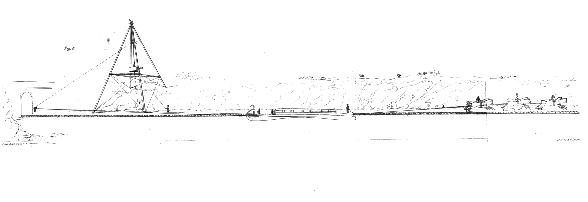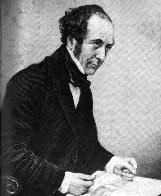

 Over one hundred and fifty years ago, while conducting experiments to
determine the most efficient design for canal boats, a young Scottish
engineer named John Scott Russell (1808-1882) made a remarkable
scientific discovery. As he described it in his "Report on Waves":
(Report of the fourteenth meeting of the British Association for the
Advancement of Science, York, September 1844 (London 1845), pp 311-390,
Plates XLVII-LVII).
Over one hundred and fifty years ago, while conducting experiments to
determine the most efficient design for canal boats, a young Scottish
engineer named John Scott Russell (1808-1882) made a remarkable
scientific discovery. As he described it in his "Report on Waves":
(Report of the fourteenth meeting of the British Association for the
Advancement of Science, York, September 1844 (London 1845), pp 311-390,
Plates XLVII-LVII).``I was observing the motion of a boat which was rapidly drawn along a narrow channel by a pair of horses, when the boat suddenly stopped - not so the mass of water in the channel which it had put in motion; it accumulated round the prow of the vessel in a state of violent agitation, then suddenly leaving it behind, rolled forward with great velocity, assuming the form of a large solitary elevation, a rounded, smooth and well-defined heap of water, which continued its course along the channel apparently without change of form or diminution of speed. I followed it on horseback, and overtook it still rolling on at a rate of some eight or nine miles an hour, preserving its original figure some thirty feet long and a foot to a foot and a half in height. Its height gradually diminished, and after a chase of one or two miles I lost it in the windings of the channel. Such, in the month of August 1834, was my first chance interview with that singular and beautiful phenomenon which I have called the Wave of Translation''.
(Cet passage en francais)
This event took place on the Union Canal at Hermiston, very close to the Riccarton campus of Heriot-Watt University, Edinburgh.
Following this discovery, Scott Russell built a 30' wave tank in his back garden and made further important observations of the properties of the solitary wave.
Throughout his life Russell remained convinced that his solitary wave (the ``Wave of Translation'') was of fundamental importance, but nineteenth and early twentieth century scientists thought otherwise. His fame has rested on other achievements. To mention some of his many and varied activities, he developed the "wave line" system of hull construction which revolutionized nineteenth century naval architecture, and was awarded the gold medal of the Royal Society of Edinburgh in 1837. He began steam carriage service between Glasgow and Paisley in 1834, and made one of the first experimental observations of the "Doppler shift" of sound frequency as a train passes. He reorganized the Royal Society of Arts, founded the Institution of Naval Architects and in 1849 was elected Fellow of the Royal Society of London. He designed (with Brunel) the "Great Eastern" and built it; he designed the Vienna Rotunda and helped to design Britain's first armoured warship (the "Warrior"). He developed a curriculum for technical education in Britain, and it has recently become known that he attempted to negotiate peace during the American Civil War.
It was not until the mid 1960's when applied scientists began to use modern digital computers to study nonlinear wave propagation that the soundness of Russell's early ideas began to be appreciated. He viewed the solitary wave as a self-sufficient dynamic entity, a "thing" displaying many properties of a particle. From the modern perspective it is used as a constructive element to formulate the complex dynamical behaviour of wave systems throughout science: from hydrodynamics to nonlinear optics, from plasmas to shock waves, from tornados to the Great Red Spot of Jupiter, from the elementary particles of matter to the elementary particles of thought.
For a more detailed and technical account of the solitary wave, see for example R K Bullough, "The Wave" "par excellence", the solitary, progressive great wave of equilibrium of the fluid - an early history of the solitary wave, in Solitons, ed. M Lakshmanan, Springer Series in Nonlinear Dynamics, 1988, 150-281, or "The Spirited Horse, the Engineer, and the Mathematician: Water Waves in Nineteenth-Century Hydrodynamics", O. Darrigol, Arch. Hist. Exact Sci. 58 (2003) 21-95, or "The origins of water wave theory", Alex D.D. Craik, Annual Review of Fluid Mechanics (2004), Vol. 36, pp. 1-28.
Electronic scans of some of Scott Russell's water wave papers are listed below